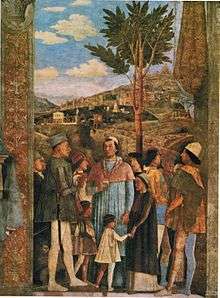Camera degli Sposi


The Camera degli Sposi ("bridal chamber"), sometimes known as the Camera picta ("painted chamber"), is a room frescoed with illusionistic paintings by Andrea Mantegna in the Ducal Palace, Mantua, Italy.[1][2] It was painted between 1465 and 1474 and commissioned by Ludovico III Gonzaga, and is notable for the use of trompe l'oeil details and its di sotto in sù ceiling.

The chronological sequence of the paintings has been recently discovered: the painter started from the vault by dry painting in the background small bits particularly those of the oculus and the wreath surrounding it. Then he moved on to the ‘Court scene’ where he used a mysterious oily tempera dry laid out on the surface. The east and south walls followed, with the traditional fresco technique representing heavy curtains. Finally the ‘Meeting scene’ on the west wall was painted, always ‘a fresco’ but in very small bits which confirms an almost ten-year period of work on that part of the chamber.[3]
The walls
The "Court Scene" on the north wall shows Ludovico Gonzaga, dressed informally, with his wife Barbara of Brandenburg. They are seated with their relatives, while a group of courtiers fill the rest of the wall. The figures are interacting in an illusionistically expanded space.
On the west wall is the "Meeting scene". This fresco shows Ludovico in official robes in an ideal meeting with his son, Cardinal Francesco Gonzaga, the Holy Roman Emperor Frederick III and Christian I of Denmark.
The commission is far from being explained by scholars. The traditional interpretation sees the frescos as linked to the election as Cardinal of Ludovico's son Francesco Gonzaga, which took place on January 1, 1462: the Court scene should then represent the Marquis receiving the news, and the Meeting Scene should see father and son reunited in the happy event.[3]
The mature and strongly-built figure of Francesco though, doesn’t seem to match with his age in 1461, which was only 17 (an early portrait held today in Naples confirms this). For this reason, these frescos could refer to a later visit of Cardinal Francesco to Mantua, perhaps on August 1472 when he was given the title of St. Andrew.[3]
The ceiling
Mantegna's playful ceiling presents an oculus that illusionistically opens into a blue sky, with foreshortened putti playfully frolicking around a balustrade. This was one of the earliest di sotto in sù ceiling paintings.
References
- ↑ Paoletti, John T.; Gary M. Radke (2005). Art, Power, and Patronage in Renaissance Italy. Upper Saddle River: Pearson/Prentice Hall. pp. 356–359..
- ↑ Schneider Adams, Laurie (2001). Italian Renaissance Art. Boulder: Westview Press. pp. 262–267..
- 1 2 3 "Mantua Tourist Guide, The Bridal Chamber". Retrieved 4 April 2011..
External links
| Wikimedia Commons has media related to Camera degli Sposi. |
- Mantua tourist guide Mantua tourist guide
Coordinates: 45°09′40″N 10°48′00″E / 45.16111°N 10.80000°E